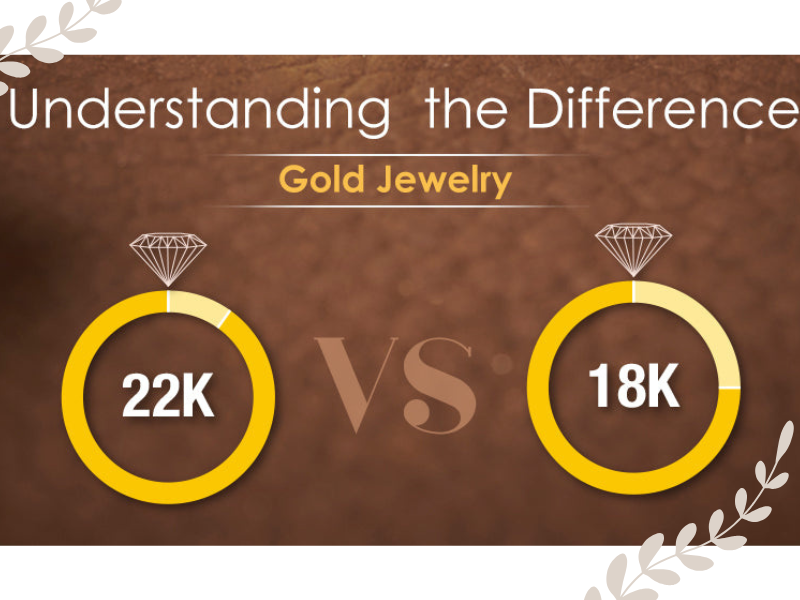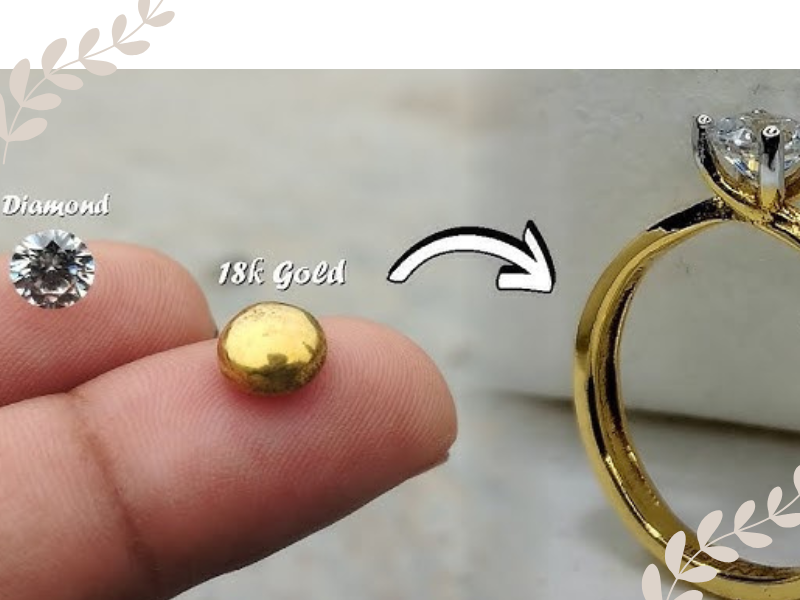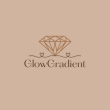Diamond jewellery made in 18kt gold has become the standard in the world of fine jewellery. When it comes to diamond jewellery, the setting is just as important as the stone itself. You have heard of different karat of gold being used, like 24kt, 22kt, 18kt, and even 14kt. But have you ever wondered why 18kt gold is often the gold of choice for diamond jewellery? While 24kt gold may sound more prestigious due to its purity, it’s actually not the ideal match for holding precious stones like diamonds.
In this blog, we will explore what 18kt gold is, how it compares with 24kt gold, and why it is the preferred choice for crafting diamond jewellery. We’ll also share some essential tips for caring for your 18kt gold diamond piece to ensure they remain beautiful for year.
What is 18K Gold?
18K gold is a type of gold that contains 75% pure gold and 25% other metals like copper, silver, or palladium. This results combination in a material that retains much of gold’s desirable, its rich yellow color and resistance to tarnish—while being stronger and more durable than pure gold.
The term “18kt” (or 18K) refers to the gold’s purity on a scale of 24. So, 18kt gold means 18 parts gold and 6 parts alloying metals. It is widely used in fine jewellery and especially favoured in pieces that corporate precious stones like diamonds.
18kt Gold vs 24kt Gold — What’s the Difference?

18kt gold: 18kt gold is composed of 75% pure gold mixed with 25% alloy metals such as copper, silver, or palladium. This added metals enhance its durability without compromising too much on the gold’s natural beauty. The result is a metal that retains the luxurious appearance of gold while being much more resilient to daily wear. It is strong enough to hold a diamond.
24kt gold: 24kt gold is pure gold, containing 99.9% of the precious metal. It has a rich, deep yellow and is highly valued for its purity. However, this purity comes with a downside: it is extremely soft. 24kt gold scratching, and losing shape, making it unsuitable for jewellery that needs to hold gemstones like diamonds securely. This is not strong as 18kt gold.
Why 18kt Gold Is the Preferred Choice for Diamond Jewellery
While choosing gold for diamond jewellery, designers and jewellers need a metal that can hold its shape, secure the stone, and enhance the beauty of the diamonds. 18kt gold ticks all these boxes.
Durability and Strength
One of the most Core elements of any jewellery setting is its ability to Resist daily wear and tear. Since 18kt gold is Secured with other metals, it is more durable than pure gold. This added strength is Essential for diamond settings, particularly in rings, bracelets, and other pieces.
Diamonds may be the hardest natural material, but the gold that holds them must also be strong enough to keep them in place. 18kt gold provides this strength without compromising on beauty, making it an ideal foundation for secure and long-lasting designs.
A Perfect Balance of Purity and Practicality
18kt gold offers a Perfect blend. With 75% gold content, it remains luxurious and valuable, but it’s not so pure that it becomes impractical. Consumers get the satisfaction of owning a high-quality piece without the Weakness that comes with higher-purity gold.
Moreover, the alloys added to 18kt gold can improve the metal’s properties without greatly affecting its appearance. It’s this careful balance that allows designers to construct rich backdrops and bold designs while still maintaining the elegance of gold.
Enhancing the Diamond’s Brilliance
A diamond’s beauty is heavily influenced by the meta. 18kt gold—especially in white or yellow variants, acts as a perfect backdrop to showcase a diamond’s Sharpness. The strength of the metal allows for graceful grips and polished bezels, helping more light to pass through the diamond and increasing its sparkle.
- Yellow gold adds warmth and a vintage appeal to diamonds.
- White gold offers a modern, clean contrast that enhances a diamond’s fire and sparkle.
- Rose gold gives a romantic, blush-tone look that’s especially popular in engagement rings.
These options allow for greater customization and personalization in jewellery design.
Variety of Colours
Another advantage of 18kt gold is its colour utility. Depending on the combination of alloy metals, 18kt gold can come in a range of hue and saturation:
- Yellow Gold: Classic and timeless.
- White Gold: Elegant and modern, often coated with anti-tarnish plating for extra shine.
- Rose Gold: Romantic and trendy, made by adding copper.
This variety makes it easier for buyers to match their jewellery with their personal style, skin tone, or other accessories.

Caring for Your 18kt Gold Diamond Jewellery
While 18kt gold is more durable than 24kt, it still require proper care to maintain its shine and structure.
Regular Cleaning
Dirt, oil, and everyday leftover can dull the sparkle of both the gold and the diamond. To keep your jewellery looking its best:
- Use warm water and a few drops of gentle dish soap.
- Soak the jewellery for 15-20 minutes.
- Gently scrub with a soft toothbrush.
- Rinse thoroughly and dry with a soft cloth.
Avoid using hard brushes or harsh cloths that might scratch the gold.
Avoid Harsh Chemicals
Chemicals found in cleaning agents, chlorine, or even personal care products like hairsprays and perfumes can damage or discolor both the gold and the diamond. Here are a few precautions:
- Always remove jewellery before swimming, cleaning, or using beauty products.
- If exposure happens, clean the jewellery promptly.
- For white gold pieces, avoid excess wear to preserve any rhodium plating.
If your piece starts to lose its luster or becomes scratched, a professional jeweller can re-polish and restore it to its original beauty.
Proper Storage
When not wearing your 18kt gold diamond jewellery, store it properly to prevent scratches and damage.
- Keep pieces in separate compartments or pouches to avoid contact with other jewellery.
- Use a fabric-lined jewellery box or soft bags.
- Avoid storing in humid places, as moisture can advance tarnishing.
If you have particularly valuable or sentimental pieces, consider investing in anti-tarnish cloths or strips to maintain their quality over time.
